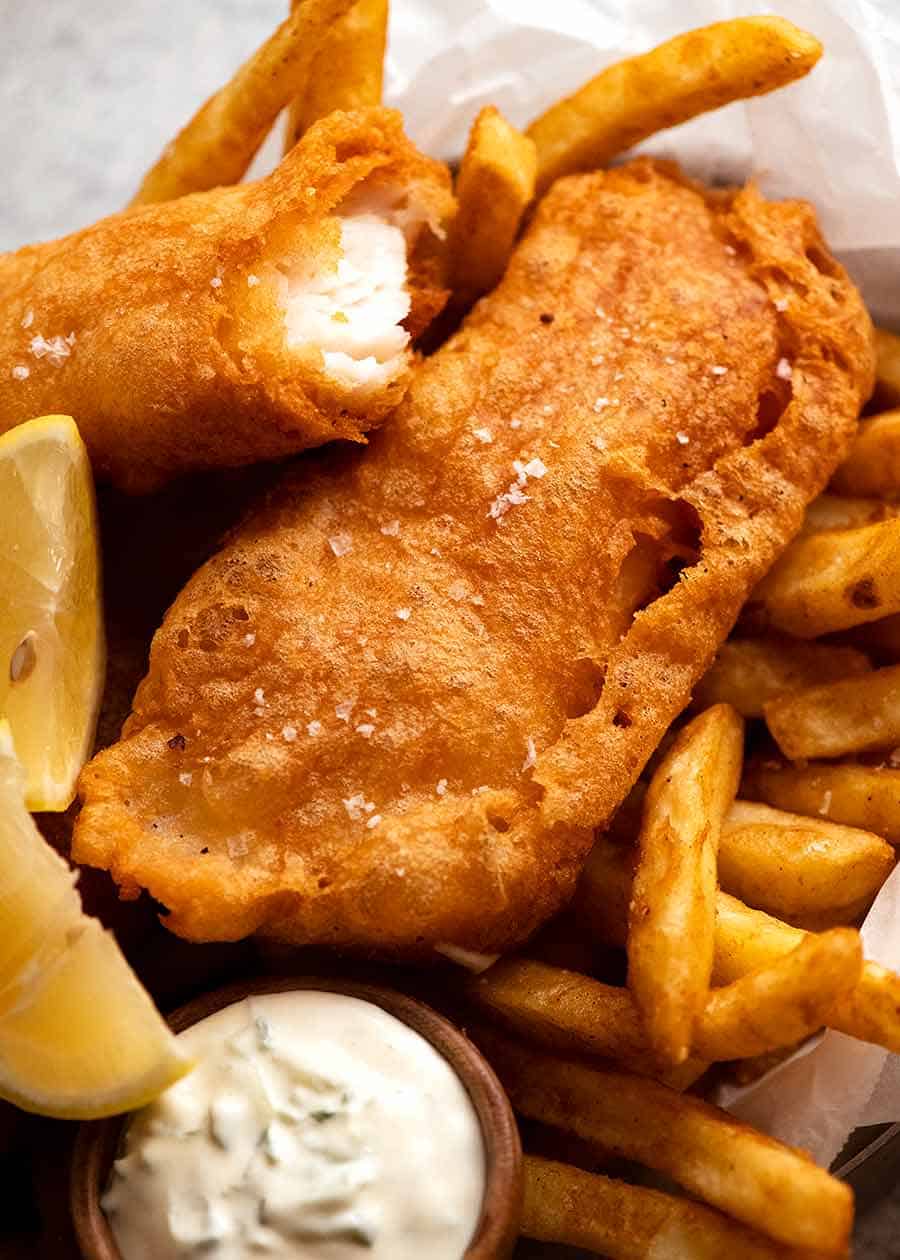Embark on a Culinary Quest: Selecting the Ideal Fish for Fish and Chips!
Hello, foodie parents! Are you ready to introduce your little ones to a classic British delight that’s crisp on the outside, tender on the inside, and utterly scrumptious through and through? Look no further! We’re here to dive into the ocean of choices to help you find the perfect fish for your homemade fish and chips recipe. So grab your apron, gather the kiddos, and let’s set sail on a culinary quest for the best!
Understanding the Tradition of Fish and Chips
Before we net our star ingredient, let’s take a brief stroll down history lane. Fish and chips is a comfort food that has warmed the hearts and bellies of families for generations. Originating from the United Kingdom in the 1800s, this dish is a staple in British cuisine and has since been embraced worldwide for its simplicity and flavor.
Now, it’s your turn to bring this classic dish to your family’s dinner table with an authentic touch and a sprinkle of love. Ready to make a splash?
The Best Types of Fish for the Ultimate Fish and Chips
Picking the right fish is crucial for creating an authentic fish and chips experience. Here are some of the top contenders that promise to turn your kitchen into the best chippy in town:
- Cod: The traditional choice for good reason, cod has a mild, slightly sweet flavor and large, flaky white meat. It fries up beautifully for that classic fish and chips taste.
- Haddock: A close relative to cod, haddock is equally popular for fish and chips in the UK. It offers a slightly firmer texture and a bit more flavor, making it a contender for those who enjoy a richer taste.
- Halibut: For a more luxurious option, try halibut. This denser, flaky fish provides a meatier bite, which stands up well to frying and offers a unique, mild flavor.
- Pollock: As a sustainable alternative to cod and haddock, pollock offers a slightly stronger “fishy” flavor but still produces delectably flaky flesh once cooked.
- Tilapia: If you want a cost-effective alternative that doesn’t skimp on flavor, tilapia is a versatile choice that absorbs the seasonings and batter well, though it is less traditional.
With these options in your culinary treasure chest, you’re on your way to making an informed choice that suits your family’s taste buds and your environmental-consciousness. Pick one, and let’s move on to preparing your catch for the fryer!
Preparing Your Fish for the Perfect Fry
Now that you’ve cast your net and caught the best fish for your meal, it’s time to prepare it for that irresistible golden crunch. Here are some pro tips to ensure you get top-notch results:
- Clean and pat your fish dry thoroughly. Excess moisture can cause the oil to splatter and the batter to slip off.
- Cut the fish into manageable pieces, not too thick, ensuring they cook evenly.
- Season the fish lightly with salt and pepper before battering. This simple step can make all the difference in flavor.
- Use a batter that is well-seasoned and chilled. The contrast of cold batter and hot oil will help you achieve that classic crispy coating.
Stay tuned as we whisk you through creating the perfect batter that’ll wrap your fish in a coat of crispy deliciousness. But first, let’s talk about the oil.

Choosing the Right Oil for Frying Fish
What’s a great batter without the perfect frying oil? The type of oil you choose for frying is vital to achieving that delightful crunch. Here are the key points to consider:
- High Smoke Point: Oils with high smoke points, such as canola, peanut, or sunflower, are best as they can reach the high temperatures needed for deep frying without burning.
- Neutral Flavor: A neutral-tasting oil ensures that the fish’s natural flavor shines through. Oils like vegetable or grapeseed are great choices.
- How Much To Use: Your frying oil should be deep enough to allow the fish to float without touching the bottom of the fryer or pan, usually about 3-4 inches.
- Fresh Oil for Best Results: Use fresh oil to avoid any off-flavors from previous fryings, ensuring your fish and chips taste just right.
- Keep An Eye On Temperature: Maintain your oil temperature around 350-375°F (175-190°C) for the perfect golden-brown crust.
Now that you have your oil ready, let’s flip to the next page of our guide and cook up some batter!
Mixing Up the Ultimate Batter for Fish and Chips
When it comes to batter, the goal is a crisp outer shell with a lovely lightness to it. Here’s how to make it:
- Combine equal parts flour and cold carbonated water or beer for a light, airy batter.
- Add a pinch of salt and any other seasonings you fancy – a hint of paprika or garlic powder can add a wonderful aroma.
- Mix the ingredients gently until just combined; a few lumps are fine and help create a crisper batter.
- Chill the batter before dipping your fish to improve the texture of the final product.
With your batter prepared, you’re just a dip and fry away from golden perfection!
5 Things Parents Should Know When Preparing Fish for Fish and Chips Recipe
As a parent, your aim is to make cooking fun, safe, and educational for your children. Here are five essential tips to ensure a smooth-sailing fish and chips experience:
- Safety First: Teach your children about kitchen safety, especially when it comes to hot oil. Supervise carefully during the frying process.
- Get the Kids Involved: Have the kids help with non-hazardous tasks like mixing the batter or seasoning the fish. It’s a great way to foster their interest in cooking!
- Make It a Learning Moment: Use the recipe as an opportunity to discuss where fish comes from, the importance of sustainable fishing, and healthy eating practices.
- Budget-Friendly Options: Consider less expensive fish like tilapia or pollock if you’re cooking on a budget, and they can still taste fantastic.
- The Importance of Balance: Fish and chips is a treat, so balance it with sides like peas or a fresh salad, and engage your kids in preparing these healthier additions.
Armed with these handy insights, you’ll not only create delectable food but also precious family memories in the kitchen!
Accompaniments and Side Dishes for Your Fish and Chips
No fish and chips meal is complete without its traditional accompaniments. Here are some that you can easily whip up at home:
- Mushy Peas: A British classic, mushy peas are simple to make and add a pop of color and nutrition to your plate.
- Tartar Sauce: Combine mayonnaise, finely chopped pickles, capers, lemon juice, and herbs for a zesty homemade tartar sauce.
- Chips: Hand-cut your potatoes and fry them twice for the perfect crispy outside and fluffy inside.
- Vinegar: A splash of malt vinegar lends a traditional British touch of tang and zest, enhancing the overall flavor.
Get creative with plating, and let your children garnish their own dish to make mealtimes more engaging!
Frying Up Your Fish to Perfection
The moment of truth has arrived! It’s time to cook your fish. Make sure to:
- Dip your fish pieces individually into the batter, allowing excess to drip off.
- Gently place them into the hot oil, being careful not to overcrowd the fryer or pan.
- Fry until the batter is a deep golden brown, usually around 5 to 7 minutes, depending on thickness.
- Drain on a rack or paper towels to remove excess oil and maintain crispiness.
- Serve immediately for the best texture and warmth, with your chosen sides and sauces.
There you have it, the blueprint to the perfect homemade fish and chips! It’s more than just a meal; it’s a chance to bring the family together and create lasting memories over a dish loved by all ages. Bon appétit, or as they say in Britain, “Tuck in”!
See more great Things to Do with Kids in New Zealand here. For more information see here
Disclaimer
The articles available via our website provide general information only and we strongly urge readers to exercise caution and conduct their own thorough research and fact-checking. The information presented should not be taken as absolute truth, and, to the maximum extent permitted by law, we will not be held liable for any inaccuracies or errors in the content. It is essential for individuals to independently verify and validate the information before making any decisions or taking any actions based on the articles.




